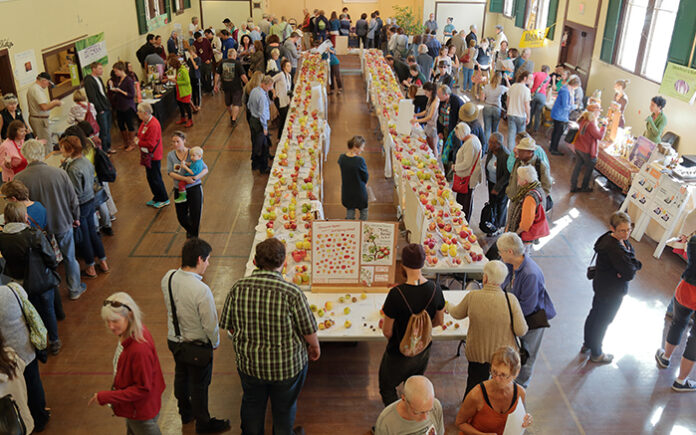Upcoming festival gets historical context
By Brian Webster
Nearly a quarter of the way through the 21st century, many Salt Spring Island residents are painfully aware of shortages: housing, drinking water, ferry staff and — during tourist season — a shortage of peace and quiet.
But there’s no shortage of skeptics on Salt Spring. So, when some refer to the island as “Canada’s Hawaii,” there’s (justifiable) rolling of the eyes. When the Province promises to repave Ganges Hill any day now… well, we’ll believe it when we see it.
So it’s understandable if skeptics doubt that Salt Spring was once western Canada’s centre of apple growing and doubly doubt whether our island can ever again rate as anything more than a novelty grower of the fruit.
After all, China produces more than 45 million tonnes of apples each year, half of the world’s total production. And Canada produces considerably less than half a per cent of that amount, ranking a mere 33rd on the list of world apple growing countries, trailing Serbia, Moldova and Algeria, among many others.
Apples are big. Canada really isn’t. And Salt Spring is a speck on Canada’s drop in the bucket.
But things were once different.
If you visited Salt Spring Island around the turn of the 20th century, you were far more likely to bump into an apple tree than a human being. An 1891 census of the island reported 435 residents, while an 1894 report by the B.C. government indicated that the apple tree population — planted by settlers over the previous two decades — was closing in on 14,000. By early in the 20th century, Salt Spring was shipping 360 tonnes of apples off the island annually. Barges carried this bounty to the mainland, where trains loaded up and transported Salt Spring apples as far east as Winnipeg.
Apples played a significant role in the settling of Salt Spring by Europeans as well as African Americans, Hawaiians and others. Unsurprisingly (although still disturbingly), it’s hard to find historical references to Indigenous peoples participating in Salt Spring’s apple growing boom, given that history as written by settlers largely ignored them in every respect.
Apple trees grew well in Salt Spring’s moderate climate and they didn’t mind the island’s uneven topography and rocky soils. While they originated in Asia and were increasingly grown everywhere in the world that wasn’t tropical or arctic, apples were particularly well suited to Salt Spring.
Apple growing continued to be significant on our island, until it wasn’t. By the 1920s, technological advances allowed vast arid areas such as B.C.’s Okanagan Valley and eastern Washington State to be irrigated and planted. Cheap fossil fuels dramatically lowered shipping costs, making viable huge orchards located far from their markets. Salt Spring’s small orchards couldn’t compete, so a sector that had been important to our island shrivelled to semi-irrelevance, except for local consumption.
Leap forward a century and Salt Spring is now a different place. More than 11,000 residents live on the island, few of them engaged in agriculture. Yet, in small ways, apple growing is coming back.
People like Harry Burton (Apple Luscious Organic Orchard), Charlie Eagle, Jessica Kavanaugh and John Pattison (Bright Farm), Bob Weeden (Whims Farm) and Salt Spring Apple Company, run by Peri Lavender and me, grow significantly diverse collections of apple varieties, even if our orchards are tiny by commercial standards. Almost certainly, there are more than 500 different apple varieties being grown here on the island.
Our harvests are sold on Salt Spring, on Vancouver Island and — increasingly — Salt Springers use them to make distinctive value-added products like cider and distilled spirits that can be sold much farther afield.
The number of people employed on Salt Spring in apple growing and processing is still very small, but it’s growing. And as Salt Springers, as well as folks living in nearby urban centres, increasingly look to learn more about they food they eat and the people who grow it, Salt Spring Island apple orcharding is experiencing a modest resurgence.
This Sunday’s Salt Spring Island Apple Festival is a great opportunity to explore our evolving world of apples. Fulford Hall will feature a display of the dozens and dozens (okay, hundreds) of apple varieties that produced fruit here on Salt Spring during 2023, collected from orchards up, down and across the island. The festival’s self-guided orchard tour includes historic orchards such as Ruckle Farm and Beddis Castle among its 17 stops, as well as modern orchards like Apple Luscious and Salt Spring Apple Company. You can visit value-added producers such as Salt Spring Wild Cider, Salt Spring Apple Company’s Ciderworks and the brand-new Sweetwater Distilling Co. And food options are numerous.
Apple growing on Salt Spring has had its ups and downs, but continues to play a role in maintaining and enriching the rural fabric of our island. Skeptics will always be an island staple and so are delicious, crunchy, sweet, tart apples of every shape and size.

